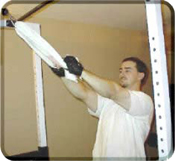Standing Rope Pullbacks
Why Is This Exercise So Effective?
This is an excellent exercise for developing the posterior deltoids. It allows you to use a lot of weight for an area of the body where, traditionally, you shouldn’t use a lot of weight or do fast, pumping reps. This exercise not only allows you to do that but actively encourages it!
How To Do It

- Stand facing a high pulley. Use a double handle or rope attachment. Grasp the rope so that your thumbs and forefingers are on the bottom. You can also use a towel looped through the hook if you don’t have a rope attachment.
- You will probably need to brace your foot up against either the seat if you’re using the lat pulldown machine or the bottom of the weight stack if using the plain pulley (that is when you start using relatively heavy weights only).
- Start with your arms straight out in front of you, thumbs towards you.

- Pull back with your rear delts by drawing your elbows as far back as you can while externally rotating your shoulders so that you form “L” shapes (with a 90-degree bend in your elbows) at the peak of the movement.
- You should attempt to make your forearms vertical at the top of the movement. When you start using heavier weight, you won’t be able to do this but by attempting to do it, you’ll increase rear delt activation.
- You will almost look like you’re doing a double biceps pose.
- It is imperative you keep your elbows as high as possible or you will turn the exercise into a biceps exercise.
How to incorporate this exercise into your workouts:
The Standing Rope Pullback can be done anywhere in your workout.
- Normally, I prefer to start with heavier pressing movements in my workouts.
- Since this is an isolation exercise, I would suggest doing it later on in a workout.
Common Errors
1. Keeping your arms horizontal
This will turn the movement into an upright-row type movement, which is undesirable. As you come to the top of the movement, your forearms should be vertical.
Tricks
1. Pull the rope apart
To fully activate the rear delts, try to pull the two ends of the rope as far apart as possible as though trying to rip it in two (the longer the rope you are able to get a hold of the better - a two foot rope is perfect). Hunch your shoulders forward at the start then force them back as you pull back.
2. Going fast
Usually rear delt exercises require strict attention to form in order to isolate the muscles. This one doesn’t.
- As long as you keep your elbows high and try to pull the rope apart, you can get away with fast, pumping reps.
- Pulling the rope apart activates the rear delts automatically.
- Using fast, pumping, high reps (a technique that normally wouldn’t work with rear delts but does in this exercise) is great for developing blood flow to the normally hard-to-reach rear delts, and can lead to much greater rear delt development than is possible with traditional rear-delt exercises.


